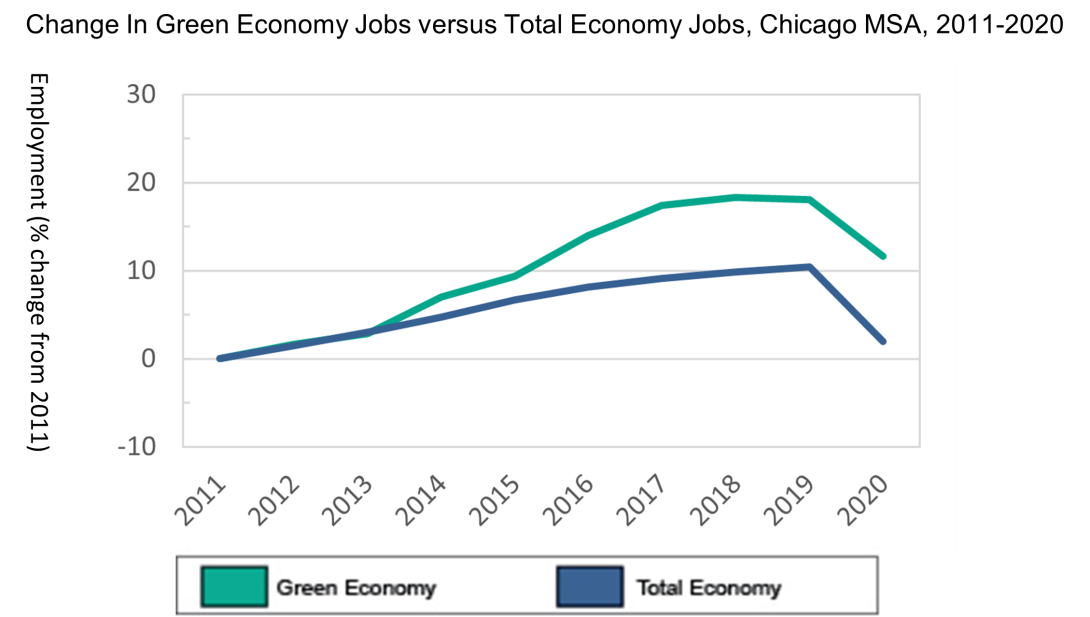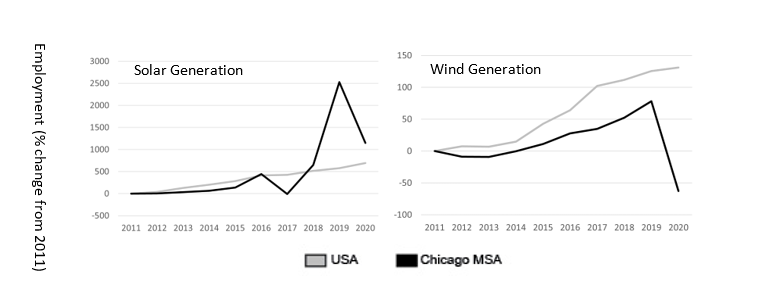The Strengths and Weaknesses of the Chicago Metropolitan Area’s Green Economy
Significant portions of the United States economy are shifting away from carbon-intensive, fossil fuel-driven activities, and moving toward a Green Economy defined by cleaner, more efficient, and higher-output practices. The Chicago Metropolitan Area (MSA) has seen steady growth in its Green Economy since 2010 (11.66%). However, it lags behind the United States as a whole, which has grown at nearly twice the rate (20.91%). The COVID-19 pandemic had a significant adverse impact on both the Green Economy and the Total Economy. Nevertheless, the Green Economy has proven to be more resilient to the pandemic, showing a smaller percentage decrease in number of jobs since 2018.
Intro Heading link

In a new report, Chicago Region’s Clean Energy Economy: Studying Changes in Employment, the UIC Voorhees Center updates its 2019 Clean Energy Report and analyzes changes in the local Green Economy since 2010, using location quotients and focusing on employment within the 82 industries that comprise the Green Economy.
The Green Economy’s subcategories (Energy Efficiency, Clean Energy Production, and Environmental Management) mimic the steady growth of the Green Economy as a whole. Regardless of region, employment in the Energy Efficiency subcategory proved to grow at the highest rate, leading by a staggering 24.5% increase in the United States. The Clean Energy Production subcategory also saw strong growth both nationally and locally, and it proved to be the most resilient subcategory to the COVID-19 pandemic in the United States. Conversely, this subcategory was hit hardest by the pandemic locally, while the Environmental Management subcategory proved to be more resilient. Furthermore, in contrast with national rates, the Clean Energy Production subcategory peaked in Cook County in 2017. Since then, it has regressed to job numbers less than that of 2011.
Compared to the nation, the Chicago Region has significant weaknesses in Solar and Wind Generation. While Solar Generation has seen huge growth in the last three years, it still lags behind the nation with less than 100 jobs in the region. Similarly, Wind Generation has seen steady growth over the last few years before its employment numbers were decimated by the COVID-19 pandemic. Semiconductor Manufacturing is also an extremely weak industry locally, with a location quotient of .04.
Solar and Wind Generation Heading link

On the other hand, Hazardous Waste Treatment and Disposal remains a strong industry in the Chicago MSA with a location quotient of 2.22. Similarly, despite large negative growth in number of jobs since 2011, Nuclear Generation remains a local strength (LQ = 1.54).
Overall, the Chicago MSA’s Green Economy lags behind the nation; subcategory level performance is similar in many cases. For this reason, we categorize the local Green Economy as “weak but advancing”, meaning that although the local Green Economy has a lower concentration of jobs than the United States, it is still growing at a steady pace. As our economy continues to transition towards a more sustainable future, we can expect the Chicago MSA to continue to make advances in its Green Economy to both lessen the impact of the looming environmental crisis and compete on a national scale with the major coastal centers of Green Economy activity.